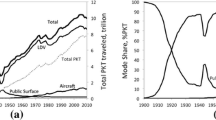Abstract
We explore how the dramatic increase in the share of leisure travel has changed aircraft utilization in the U.S. airline industry. We argue that the growth in leisure travel—which is due to increases in household income and to airline deregulation—has been responsible for an increase in airlines’ load factors. Because of data limitations, we use cross-sectional variation in the mix of passenger types to identify the effect of passenger mix on load factors. We find that routes that have a greater share of leisure travelers also have higher load factors. We use this evidence to argue that the growth of leisure travel since airline deregulation is an important driver of aircraft utilization and other characteristics of the U.S. airline industry.

Similar content being viewed by others
Notes
Airlines for America, Status of Air Travel in the United States Presentation, April 13, 2016, p. 28; and Airlines for America, Air Travelers in America: Survey Highlights, February 28, 2017, p. 6.
However, the welfare effects are ambiguous since increased load factors also imply that airplanes are more crowded, which probably contributes to lower perceived quality of the travel for many, if not all, airline travelers.
Airlines for America tabulations of Bureau of Transportation Statistics data indicate that load factors were 56% in 1977 and 83% in 2016. See http://airlines.org/dataset/annual-results-u-s-airlines-2/, accessed on Jan. 5 2018. Also, see Airline for America, Air Travelers in America: Survey Highlights, February 28, 2017, p. 6. .
From 1979 to 2017 airline price index increased from 50 to 118 (see https://fred.stlouisfed.org/series/DAITRG3A086NBEA), while the Consumer Price Index rose from 72 to 245 (see https://fred.stlouisfed.org/series/CPIAUCSL).
When \(\phi_{H}\) is smaller, then peak demand exceeds off-peak demand at these competitive prices. In this case, \(\Delta_{c} = p_{peak} - p_{{off{\text{-}}peak}}\) is defined by \(\left( {1 - F\left( {\beta ,\Delta } \right)} \right)\phi_{H} N = \left( {\phi_{L} + F\left( {\beta ,\Delta } \right)\phi_{H} } \right)N\) and the average price, \({{\left( {p_{peak} + p_{offpeak} } \right)} \mathord{\left/ {\vphantom {{\left( {p_{peak} + p_{offpeak} } \right)} 2}} \right. \kern-0pt} 2}\), is \(k + c\). And \(\Delta_{m} < \Delta_{c}\), so \({\text{LF}}_{c} \left( {\beta ,\Delta_{c} ,\gamma } \right) = 1 > {\text{LF}}_{m} \left( {\beta ,\Delta_{m} ,\gamma } \right)\).
The raw ATS dataset has 85,527 observations that correspond to round-trips that were taken by specific individuals where the principal form of transportation was commercial airplane. By comparison, individuals that took one or more airline trips for business reasons during 1995 took 4.1 trips per year on average. Alternatively, individuals who did not take an airline trip for business reasons took 1.5 airline trips per year on average.
The top-100 airports are those with the largest passenger volume. The mainline carriers included in the sample are American, Alaska, Continental, Delta, America West, Northwest, Trans World, United, USAir, and Southwest. We exclude regional and commuter carriers.
References
Berry, S., & Jia, P. (2010). Tracing the woes: An empirical analysis of the airline industry. American Economic Journal: Microeconomics, 2(3), 1–43.
Borenstein, S. (2010). Business Travel Index. Retrieved from http://www.nber.org/data/bti.html.
Dana, J. D., & Greenfield, D. (2012). Impact of passenger mix and competition on on-time performance in the airline industry. Paper Presented at the 2012 International Industrial Organization Conference.
Dana, J. D., & Orlov, E. (2014). Internet penetration and capacity utilization in the U.S. Airline Industry. American Economic Journal: Microeconomics, 6(4), 106–137.
Lee, D., & Luengo-Prado, M. J. (2005). The impact of passenger mix on reported ‘Hub Premiums’ in the U.S. Airline Industry. Southern Economic Journal, 72(2), 372–394.
Morrison, S. A. (2001). Actual, adjacent, and potential competition: Estimating the full effect of southwest airlines. Journal of Transport Economics and Policy, 35(2), 239–256.
Williams, K. (2017). Dynamic airline pricing and seat availability. Yale University, Cowles Foundation Discussion Paper No. 3003.
Author information
Authors and Affiliations
Corresponding author
Additional information
The views expressed in this article are those of the authors and do not necessarily reflect those of the Federal Trade Commission. The authors thank Han Yang for excellent research assistance and John Kwoka for helpful feedback.
Rights and permissions
About this article
Cite this article
Dana, J.D., Greenfield, D.J. The Impact of Passenger Mix on Load Factors in the Airline Industry. Rev Ind Organ 54, 111–127 (2019). https://doi.org/10.1007/s11151-018-9631-2
Published:
Issue Date:
DOI: https://doi.org/10.1007/s11151-018-9631-2




